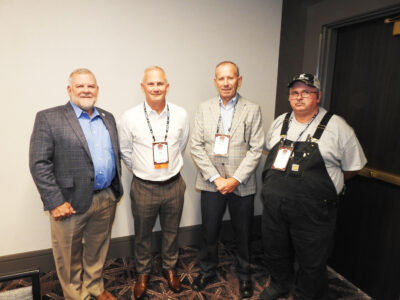We’re neck deep into the new school year, making this the perfect time to look at what’s being accomplished across the industry to address the skills gap crisis and influence future consumers why choosing wood is good.
Closing the skills gap and driving increased interest in the industry are not responsibilities we can simply assign to schools or professional educators and then walk away. These are challenges that demand our attention and participation in finding solutions.
These “off the beaten path” educational efforts are enriching the lives of students and ensuring a healthier future for them, our industry, and planet.
It Takes A Village and Then Some
Since taking on the position of Executive Director of NAFF (almost five years ago now) I’m encouraged by all the professional industry associations, individual companies, and organizations working to educate the next generation about wood, forests, and the opportunities for fulfilling these valuable careers in the forest products industry.
This is a Herculean effort that requires consistency, creativity, and all of us working together.
The Template For Every State To Copy
The Allegheny Hardwood Utilization Group (AHUG) serving the hardwood industry of Northwest and Northcentral Pennsylvania is itself an example of multilayered education that reaches people of all ages. A non-profit public private partnership, AHUG is a forest industry association committed to education and outreach.
AHUG serves 14 Pennsylvania counties, and two other utilization groups provide similar programs in other regions of the state. Executive Director Amy Shields says the program is here “to tell about the art and science of forestry–the cyclical story about how resilient and healthy forests are linked to human health.”
As part of an overarching educational plan, their WoodMobile travels to fairs, festivals, and schools teaching visitors about the history of forests, threats like insects or disease, and information on types of wood and how wood products are made.
Children and students aren’t the only groups educated. AHUG plants seeds by educating the educators with day-long workshops for teachers and guidance counselors.
Proof of the effectiveness of this approach in attracting young people into forestry programs is that in an area technical school that had seen a decline over the past ten years, now has full enrollment and more applicants than can be accepted.
Pennsylvania’s robust program has become a template for other states to follow in developing their own initiatives. For more information please email ashields@ahug.com.
Thinking Outside The Classroom
The North American Wholesale Lumber Association (NAWLA) is another shining example of how to close the skills gap with creativity.
One of their programs, the annual Traders Market event, provides education and networking and brings together buyers and suppliers. As a member of NAWLA’s Traders Market committee, Trent Johnson, Senior Manager of Lumber Services at Blue Book Services, has been active in the planning of student initiatives held in conjunction with the national meetings.
For the 2023 meeting, held in Columbus, Ohio, the committee sought ways to connect young people with the industry. Johnson says, “Young people don’t know what they don’t know. We can’t expect them to enter an industry they know nothing about.” The result was a student initiative.
The committee worked with local high schools and invited students to spend a structured day at the event. Around 40 students attended. Their day began with an introduction to the industry, followed by a guided tour through the show with introductions to a specific set of companies representing several different aspects of the industry from wholesale to manufacturing.
I had the amazing opportunity to do a presentation for these students to not only share what NAFF is doing but to get them excited about a fulfilling future in the industry.
At the upcoming 2024 Traders Market meeting in Phoenix, November 13-15, a similar initiative is planned. This year, however, the committee seeks to work with trade schools and tap into that pool of young people in their first year out of high school when many are seeking career direction. For more information please email tjohnson@bluebookservices.com.
Hello Future, Goodbye Debt
The UFP Business School is tapping into an even wider age group for potential students, enrolling individuals of all ages and experience levels, from age 18 on up. Students come from all parts of the country – the current class includes students from Idaho, Georgia, Carolinas, and Texas. Full scholarship tuition is available for students and all students are employed at UFP while enrolled.
Established in 2016, the program seeks to prepare students for real work in the real world. It grew out of a desire to have students ready to move seamlessly into their roles at work, without the needs for supplemental training to bridge classroom studies with the demands of the job.
UFP created their own curriculum taught by the CEO and other working company executives.
Scholarship-based tuition allows the students to begin their careers with a business degree without the burden of college debt.
“We figure out how to invest in each individual, looking at their talent and seeing how to develop their potential, matching students with jobs that focus on their strengths.”
UFP is changing the pattern and expanding the opportunities for entry into the forest products industry–while helping students keep money in their pocket instead of piling up student debt. To learn more visit info@ufpbusinessschool.com.
Never Too Early to Start
Along the same educational lines, thinking beyond the standard curriculum, at the North American Forest Foundation we’re working to advocate for the industry to plant seeds of interest in the minds of young people.
Our signature Truth About Trees Kits are placed in the hands of elementary teachers and counselors, where a single kit serves more than one classroom and is reusable year after year. Dispelling the myths and reinforcing the benefits and impact of choosing wood, for good.
Addressing the problem requires a layered approach. You can’t expect young people to be driven to enter careers that they never knew existed. Seeds planted in the elementary grades need to be nurtured.
Our upcoming gamified app for junior high school students is being designed to bridge the gap between elementary and high school learning.
As an educational and industry advocate, we also aim to inspire more companies and individuals to find ways to contribute to closing the skills gap and attracting more people into the industry.
The examples shared here are just a sampling of the activities and programs currently in operation. Let them inspire your next step in bridging the skills gap.
You can make a difference too by becoming an annual donor or anchor sponsor to expedite the release of the junior high app! Contact Allison DeFord today at adeford@northamericanforestfoundation.org.







